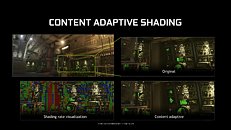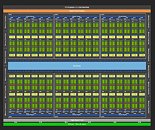Raevenlord
News Editor
- Joined
- Aug 12, 2016
- Messages
- 3,755 (1.18/day)
- Location
- Portugal
| System Name | The Ryzening |
|---|---|
| Processor | AMD Ryzen 9 5900X |
| Motherboard | MSI X570 MAG TOMAHAWK |
| Cooling | Lian Li Galahad 360mm AIO |
| Memory | 32 GB G.Skill Trident Z F4-3733 (4x 8 GB) |
| Video Card(s) | Gigabyte RTX 3070 Ti |
| Storage | Boot: Transcend MTE220S 2TB, Kintson A2000 1TB, Seagate Firewolf Pro 14 TB |
| Display(s) | Acer Nitro VG270UP (1440p 144 Hz IPS) |
| Case | Lian Li O11DX Dynamic White |
| Audio Device(s) | iFi Audio Zen DAC |
| Power Supply | Seasonic Focus+ 750 W |
| Mouse | Cooler Master Masterkeys Lite L |
| Keyboard | Cooler Master Masterkeys Lite L |
| Software | Windows 10 x64 |
You may remember that we covered in detail the new technologies being implemented on NVIDIA's new brainchild, Turing, back when the architecture and its whitepaper were initially announced. One of the pieces of technology we talked about back then was Content Adaptive Shading, a new technique that would allow for smart trade-offs in image quality for added performance - potentially allowing for increased overall rendering resolutions at a much lesser impact cost.
The tech is now simply known as Adaptive Shading, and it basically works as a post-process step that looks at previous frames to calculate which determine quality conditions for the next one - lowered detail areas such as skies, flat walls, or even shadowed portions of objects require lesser amounts of shading detail, and thus, their shading rates can be reduced from a per-pixel shading to four pixels per shading ratio. And this new feature, which was originally showcased on MachineGames' Wolfenstein II: The New Colossus, will finally be implemented in working form on that particular game, via a patch that's being released on November 19th. This is the first title to make use of this technology - and hopefully, it isn't the last.



View at TechPowerUp Main Site
The tech is now simply known as Adaptive Shading, and it basically works as a post-process step that looks at previous frames to calculate which determine quality conditions for the next one - lowered detail areas such as skies, flat walls, or even shadowed portions of objects require lesser amounts of shading detail, and thus, their shading rates can be reduced from a per-pixel shading to four pixels per shading ratio. And this new feature, which was originally showcased on MachineGames' Wolfenstein II: The New Colossus, will finally be implemented in working form on that particular game, via a patch that's being released on November 19th. This is the first title to make use of this technology - and hopefully, it isn't the last.



View at TechPowerUp Main Site







